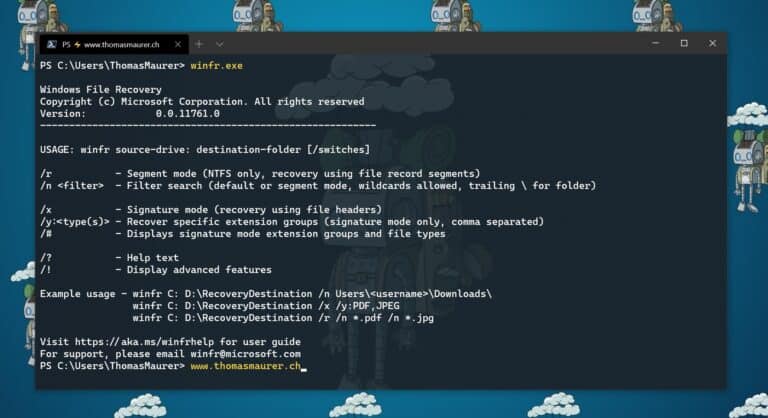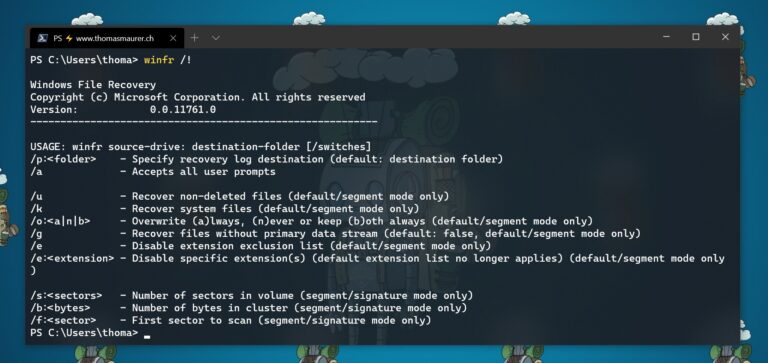Recover Files on Windows using the Windows File Recovery Tool
- 时间: 2020-06-29 09:49:26
Did you accidentally delete an important file, wiping a hard drive or partition, or need to restore corrupted files and data? We all have been there, with the newly released Microsoft Windows File Recovery tool you can recover and restore files on Windows. In this blog post, I am going to show you how you can recover and restore files on Windows using theWindows File Recoverytool. You can also use this tool to recover files from external drives and SD cards.
Accidentally deleted an important file? Wiped clean your hard drive? Unsure of what to do with corrupted data? Windows File Recovery can help recover your personal data.For photos, documents, videos and more, Windows File Recovery supports many file types to help ensure that your data is not permanently lost.Recovering from a camera or SD card? Try Signature mode, which expands beyond NTFS recovery and caters to your storage device needs. Let this app be your first choice for helping to find what you need from your hard drive, SSD (*limited by TRIM), USB drive, or memory cards.
I also want to make clear that this is no replacement for a backup, likeWindows File History,Azure Backup, or products from third-party vendors. This tool is more of an emergency utility, you can restore files that were not backed up.
Requirements
To use the Windows File Recovery Tool, you have a couple of requirements.
- You will need to run Windows 10, version 2004 (Build 19041), or later.
- You can download the Windows File Recovery Tool from theMicrosoft Store.
- The source and destination drives must be different. If you don’t have a second drive on your computer, you can use a USB drive as a target for the restore. If you are storing form an SD card or external drive, you can use the internal system drive (often the C: drive) as a target.
- The tool supports different file systems such as NTFS, ReFS, FAT, and exFAT. If you are restoring files from a non-NTFS file system, you will need to run the commands in signature mode using the /x parameter.
How to recover a file on Windows using the Windows File Recovery tool
Here is a quick example of how you can restore a file you have accidentally deleted on your machine using the Windows File Recovery tool. First, open the Windows File Recovery Tool from the Start menu or open upPowerShell or theWindows Terminal as an administrator.
You can type the command “winfr” to see your options.

Windows File Recovery Tool WinFR
Now you can run commands to recover files with different options. You can restore a specific file, a folder, different files based on filetype, or names using wildcard. The syntax is straightforward:
winfr sourcedrive: destinationdrive: [/switches]
Here is how you can recover a particular file from the C: drive and restore it to my external USB drive (E:). Theses drive The file I am going o restore here is called scorereport.pdf.
winfr C: E: /n \Users\ThomasMaurer\Documents\ImportantFiles\scorereport.pdf
You can also restore a complete folder using the following command.
winfr C: E: /n \Users\ThomasMaurer\Documents\ImportantFiles\
The Windows File Recovery Tools also comes with different modes called Default, Segment, and Signature.
To restore a recently deleted file on an NTFS file system, you can use the default mode, as shown above. If you need to restore a file from an NTFS file system which was deleted a while ago, after formatting the disk, or a corrupted disk, you first try segment mode using the /r switch.
winfr C: E: /r /n \Users\ThomasMaurer\Documents\ImportantFiles\
If that doesn’t restore your file or you need to restore a file from a non-NTFS filesystem such as FAT, exFAT, or ReFS, you should use signature mode. For example, with this command, you can Recover JPEG and PNG photos from your F: drive and to the recovery folder on the E: drive. (For example, to restore from an SD card.)
winfr F: E: /x /y:JPEG,PNG
There are many more options available, and you can find more in thisMicrosoft Support article. You also have some advanced options available.

WinFR Advanced Options
Conclusion
I hope this blog post provides you with a quick look at how you can restore and recover files using the Windows File Recovery tool. If you have any questions, feel free to leave a comment.